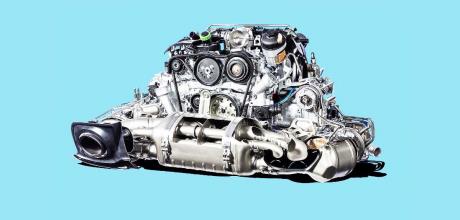The Porsche 911 electrifies
How the world’s favourite sports car will embrace e-power.
HIDDEN IN PLAIN SIGHT 1
It was there all along, of course, the 992-gen 911’s flat-six engine (right) and gearbox the Trojan horse within which Porsche engineers stashed the foundations for future hybrid assistance. Several measures were taken to ensure the 992 could, in future, be electrified, not least a shorter gearset and the mount points to package a compact e-motor. The PDK transmission was also uprated, its higher torque capacity all the better for coping with the vastly increased mechanical twist e-assistance offers.
The 911’s four-wheel drive was also made more adaptable than before, with the front/rear torque split flexibility to be able to more effectively shunt about and exploit a hybrid powertrain’s prodigious performance. The move away from an electro-mechanical brake booster to a fully electric successor also pointed at future electrification. Such a system gives engineers the flexibility to more deftly compensate for the inconsistent negative torque regenerative charging throws into the dynamic mixing bowl.
HIDDEN IN PLAIN SIGHT 2
As is the Porsche way, its adventures into the electrification of the sports car so fundamental to its brand image have been going on in front of closed doors as well as behind them.
First came the Mission R, a radically styled two-seat production racer concept that showed Porsche has no intention of stepping away from customer motorsport any time soon.
All-wheel drive, with more than 1000bhp available in short bursts, the Mission R was loud (geartrain whine mostly, plus wind and tyre road) and it was fast, though the slightly numb dynamic repertoire left us a little cold when we drove it, and this despite Porsche’s eschewal of the underfloor slab battery so fundamental to the vast majority of EVs.
‘In a sports car, the silhouette should be as low and the driver needs to be sitting as low as possible,’ member of the board for R&D Dr Steiner told CAR at the time. ‘There is no space for the battery below the seat or the driver’s feet. Instead we have our core battery design. In terms of packaging and centre of gravity it’s more or less a copy of a mid-engined design. But now it’s not the engine – because the electric motors are pretty small – it’s the battery. Now you have a weight distribution optimised for sporty driving.’
The related GT4 e-Performance was conceptually very similar but used a split battery approach (something Ferrari also appears to be working on for its 2025 electric supercar, if patents are to be believed), with the overall capacity split across three smaller batteries located throughout the car’s structure. It’s an approach likely to be under consideration for the 911 given Porsche can’t simply replace its rear-mounted engine with a rear-mounted battery…
‘We have explored this idea in CAD,’ R&D man Steiner told CAR. ‘We did such studies. But there was never a prototype like that – too many problems [not least with safety; batteries need to be within the wheelbase]. We would not like to see this on the road with today’s technology. But we could split the battery, with a T-shaped layout; big battery pack behind the seats and the rest in a corridor between them.’ The electric 911, when it arrives, could use a dedicated version of Porsche’s SSP platform. Set to underpin the electric next-gen Panamera and Taycan (not to mention a new Audi A8), Porsche engineers describe SSP as performance-orientated – it promises a sharper drive than PPE (shown above), due soon underneath the electric Macan.


